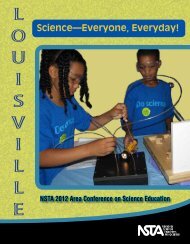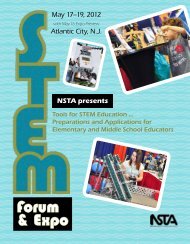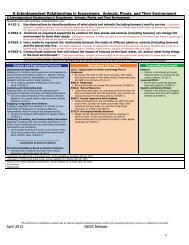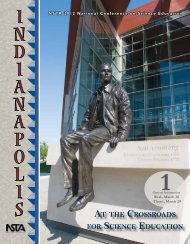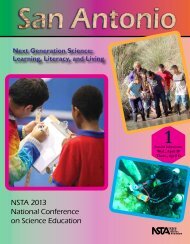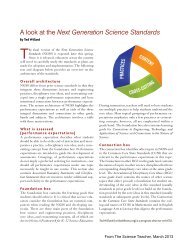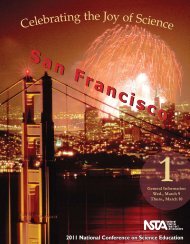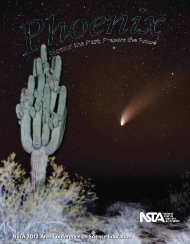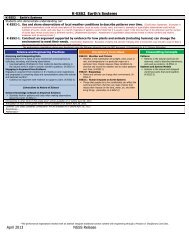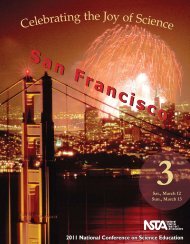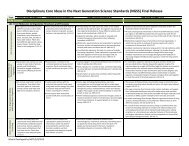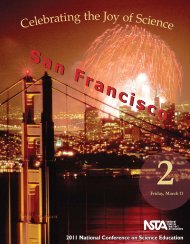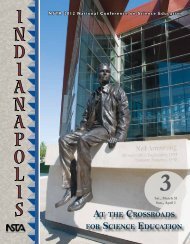Atlanta Conference Program
Atlanta Conference Program
Atlanta Conference Program
You also want an ePaper? Increase the reach of your titles
YUMPU automatically turns print PDFs into web optimized ePapers that Google loves.
Thursday, 10:00–11:15 AM<br />
Hands-On Activities to Explore Environmental<br />
Change<br />
(Env)<br />
(Grades 9–12)<br />
B207, GWCC<br />
Sponsor: Carolina Biological Supply<br />
Carolina Teaching Partner<br />
Simulate how human influence effects habitat degradation<br />
in a terrestrial ecosystem, model how global warming and<br />
ocean acidification affect marine habitats, and investigate<br />
the advantages and disadvantages of four different population<br />
sampling methods. These real-world scenarios will challenge<br />
and engage your students. Door prizes!<br />
NGSS and Scientific Practices—More Than Photoshopping<br />
Models’ Flaws<br />
(Gen)<br />
(Grades 5–8)<br />
B208, GWCC<br />
Sponsor: Sangari Active Science<br />
Joseph Krajcik, Michigan State University, East Lansing<br />
What comes to mind when you hear the word “model” Solar<br />
system mobiles Cells in pie plates New standards require<br />
going beyond the models used in science for years! Come<br />
engage in modeling activities for middle schoolers and unpack<br />
how to think about models you use now in ways consistent<br />
with the highly anticipated NGSS.<br />
I Think There’s a Genetically Engineered Fly in My<br />
Genetically Modified Pea Soup!<br />
(Bio)<br />
(Grades 9–12)<br />
B209, GWCC<br />
Sponsor: LAB-AIDS, Inc.<br />
Barbara Nagle, The Lawrence Hall of Science, University<br />
of California, Berkeley<br />
Students often have trouble conceptualizing how selective<br />
gene expression works. In this workshop, participants will<br />
use manipulatives to teach this concept and see how it is<br />
connected to genetic engineering. Innovative activities are<br />
selected from the new Science & Global Issues biology program<br />
by SEPUP and LAB-AIDS. Activities focus on ways to integrate<br />
this topic as a relevant and engaging sustainability issue<br />
into teaching about selective gene expression.<br />
That’s Amazing! Explore the Bizarre, Cool, and<br />
Exciting World of Project-based Biology (Bio)<br />
(Grades K–12)<br />
B309, GWCC<br />
Sponsor: Houghton Mifflin Harcourt<br />
Michael Heithaus, Florida International University,<br />
North Miami<br />
Drawing from cutting-edge research from around the world<br />
and fast-paced high-quality productions, That’s Amazing<br />
project-based videos grab students’ attention immediately.<br />
Kicking off with a high school student–posed question about<br />
the bizarre, the cool, and the exciting, Mike Heithaus takes<br />
students on a scientific investigation with the experts, but it’s<br />
up to the students to work with the data they see collected<br />
to solve the mystery…or debate its merits! By engaging students’<br />
curiosity and immersing them in the scientific process,<br />
these project-based videos can help students grasp and retain<br />
key science standards. In this session, Mike will draw on his<br />
background in field research and documentary filmmaking<br />
to help you make the most of this exciting teaching tool.<br />
Wait! The Chips I Ate Were a Genetically Modified<br />
Organism (GMO)<br />
(Bio)<br />
(Grades 8–College)<br />
B310, GWCC<br />
Sponsor: Edvotek Inc.<br />
Jack Chirikjian (info@edvotek.com), Khuyen Mai (info@<br />
edvotek.com), and Tom Cynkar (info@edvotek.com), Edvotek<br />
Inc., Washington, D.C.<br />
Because the U.S. Food and Drug Administration does not<br />
require foods to be labeled as GMO, it is difficult to discern<br />
GMO products in your grocery store. By extracting DNA<br />
from soybean and FRITOS® chips from GMOs and performing<br />
a polymerase chain reaction (PCR), you will determine if<br />
any genetically modified indicator genes are present. Amplified<br />
DNA is separated and sized by gel electrophoresis. Take<br />
home a free T-shirt and flash drive.<br />
Hurricanes and Volcanoes<br />
(Earth)<br />
(Grades 4–12)<br />
B212, GWCC<br />
Sponsor: Simulation Curriculum Corp.<br />
Herb Koller (hkoller@simcur.com), Simulation Curriculum<br />
Corp., Minnetonka, Minn.<br />
What are hurricanes and how are they formed Why are<br />
volcanoes common in certain parts of the world With The<br />
Layered Earth, students can visualize, measure, and manipulate<br />
these forces of nature as well as basic concepts of geology<br />
and meteorology using a virtual model of Earth.<br />
NSTA <strong>Atlanta</strong> Area <strong>Conference</strong> on Science Education<br />
47



